Corregidor:
Resolute Isle

On this forlorn speck of land from 1941 to 1942, an embattled force of
Filipino and American soldiers fought one of the great delaying actions
of World War II. Less than half a century before that, the island had
merely watched a U.S. naval squadron destroy a Spanish fleet deployed
in Manila bay. Much earlier than that, the island reverberated with the
sounds of cannons as Spanish galleons battled Dutch privateers.
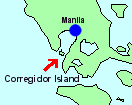 Situated
26 miles West of Manila, Corregidor lies just off the southern tip of
the Bataan Peninsula and guards the entrance to Manila Bay. Dubbed as
the "Rock", the island is part of huge limestone formation that
juts out of the bay waters. It is about four miles long and half a mile
wide at its widest point. It was fortified by the Americans in 1902 as
a military reservation and became a part of the part of the Harbor Defense
system of Manila and Subic Bay because of its strategic location. During
the Spanish era,
Situated
26 miles West of Manila, Corregidor lies just off the southern tip of
the Bataan Peninsula and guards the entrance to Manila Bay. Dubbed as
the "Rock", the island is part of huge limestone formation that
juts out of the bay waters. It is about four miles long and half a mile
wide at its widest point. It was fortified by the Americans in 1902 as
a military reservation and became a part of the part of the Harbor Defense
system of Manila and Subic Bay because of its strategic location. During
the Spanish era,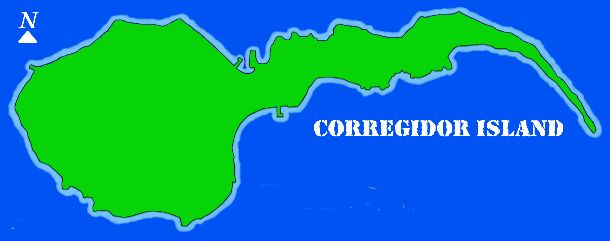 this tadpole-shaped island was used as a signal station, where bonfires
were built to apprise Manila of a home-coming galleon. Later on, Spaniards
built a lighthouse on the island. The name Corregidor comes from the spanish
word "magistrate" Smaller islands in its periphery have been
given such whimsical names as El Fraile (The Friar), La Monja (The Nun),
Caballo (Horse) and Carabao (Water Buffalo). Except for La Monja, all
these islands were fortified.
this tadpole-shaped island was used as a signal station, where bonfires
were built to apprise Manila of a home-coming galleon. Later on, Spaniards
built a lighthouse on the island. The name Corregidor comes from the spanish
word "magistrate" Smaller islands in its periphery have been
given such whimsical names as El Fraile (The Friar), La Monja (The Nun),
Caballo (Horse) and Carabao (Water Buffalo). Except for La Monja, all
these islands were fortified.
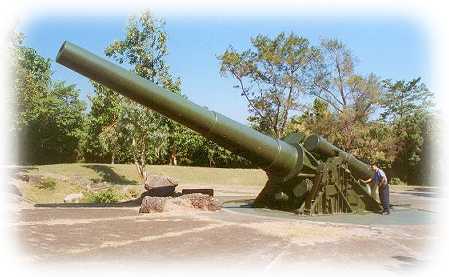
In 1941, the big guns of Corregidor were used to support Filipino and
American defenders of Bataan until the island itself was invaded. The
incessant pounding by Japanese guns, combined with intermittent bombing
runs weakened its defenses and eventually led to its surrender. On January
22, 1945, Corregidor was once again caught in the fury of war as Americans
retook the island after an epic. bloody battle.
Points of Interest
Bottomside
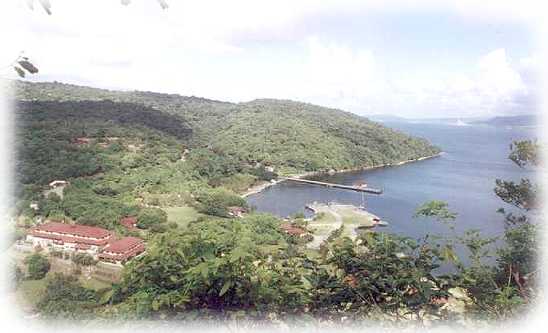
See famous Lorcha Dock from where Gen. MacArthur departed for Darwin,
Australia, and uttered the the words "I shall return". (Actual
site is off-frame, slightly to the right of this photo's point of view).
One can stroll on the beaches on the Northern and Southern parts of the
island, or have a picnic on lush greens. From the North Dock, one can
see the picturesque Bataan Peninsula
Malinta Tunnel

Constructed from 1921 to 1932, Malinta Tunnel has a main tunnel 835 feet
long and 24 feet wide. It has 24 laterals which branch out from the main
tunnel. Originally designed as an arsenal and an underground hospital,
its unique location beneath Malinta Hill made it an ideal bomb-proof headquarters
for embattled Filipino and American troops. During the siege, it served
as the seat of the Philippine Government under President Manuel L. Quezon.
Today, visitors can experience the the thrills of Malinta Tunnel in a
vividly staged Light and Sound show. Scripted by the late Lamberto Avellana,
an outstanding film director, the show is a reenactment of World War II's
dramatic events. A plan to erect a Hospital Museum within Malinta's historic
tunnels is also under way.
Battery Way
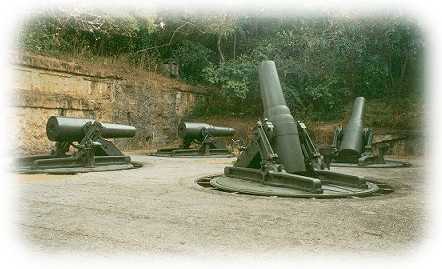
Completed in 1913, this battery was armed with four 12-inch mortars capable
of firing up to 14,610 yards in any direction at the rate of one round
per minute (per mortar). Three of the serviceable mortars opened fire
on April 28, 1942; and on May 2, two of these were hit. On May 6, after
more than 12 hours of continuous firing, the remaining mortar finally
froze tight. It was the last of Corregidor's "concrete artillery"
to to cease firing before the surrender.
Battery Hearn
This 12-inch seacoast gun had a maximum range of 29,500 yards and was capable of firing in any direction. One of the last major additions to Corregidor's defense system, it was captured nearly intact by the Japanese. It had been in action, firing towards Cavite from February 1942, and on April 8 to 9, towards Bataan.
Topside
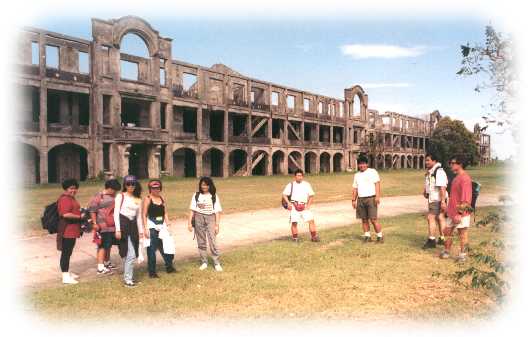 So-called
because it is the highest point in the island, topside was the nerve center
of Fort Mills. (Fort Mills is the nom-de-guerre of Corregidor Island.).
Located here was the Harbor Defense Headquarters, Topside (or "Mile-long")
Barracks, Senior Officers' Quarters, Parade Grounds, Golf course, Post
Hospital and the old Spanish Lighthouse. All the major caliber seacoast
artillery emplacements were also situated in this area. Their lofty positions
gave the island's defenders an excellent vantage point that covered the
narrow North and South entrances into Manila Bay.
So-called
because it is the highest point in the island, topside was the nerve center
of Fort Mills. (Fort Mills is the nom-de-guerre of Corregidor Island.).
Located here was the Harbor Defense Headquarters, Topside (or "Mile-long")
Barracks, Senior Officers' Quarters, Parade Grounds, Golf course, Post
Hospital and the old Spanish Lighthouse. All the major caliber seacoast
artillery emplacements were also situated in this area. Their lofty positions
gave the island's defenders an excellent vantage point that covered the
narrow North and South entrances into Manila Bay.
Pacific War Memorial
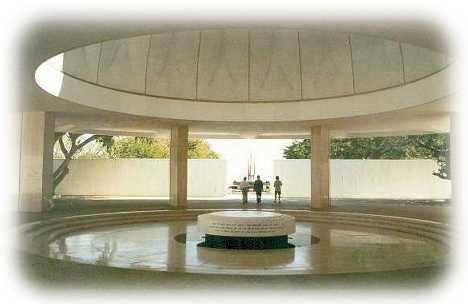
The highlight the regular Corregidor tour is a visit to the Pacific War
Memorial. Built by the U.S. Government, it was completed in 1968. The
memorial is dedicated to Filipino and American soldiers who shed their
blood on Corregidor. It stands on the highest part of Corregidor on the
the west side of the island. Shaded by giant acacia trees, its walkways
lead into a dome-capped circular structure, in the center of which lies
a beautiful altar-like stone structure. In the distance lies the Eternal
Flame monument, an iron sculpture erected to commemorate the valor and
fortitude of those who fought in World War II.
Cine Corregidor
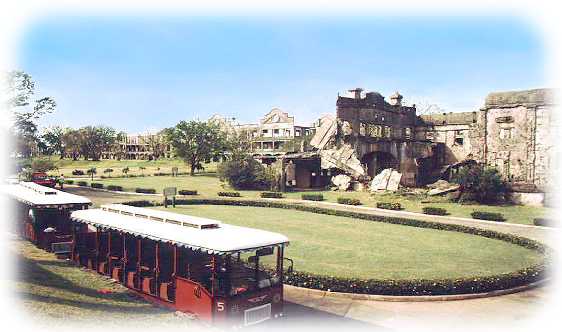
To the north of the memorial stands the ruins of Cine Corregidor, the
old movie theater. President Quezon's and Gen. Douglas MacArthur's official
staff cars are permanently dispalyed and parked in a corner of the theatre
that used to house the box office. Behind Cine Corregidor is the island
museum where war photos, artifacts, and other memorabilia from that bygone
era are displaye. There, you'll see swords, machine guns, old uniforms,
helmets, old currency, etc. Don't miss it!
Spanish Lighthouse
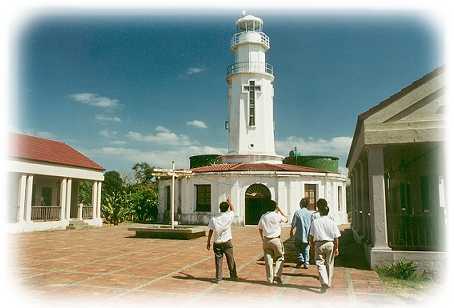
Delight in a breathtaking view of Manila Bay, the South China Sea and
the island itself from atop the the lighthouse. With an elevation of 628
feet above sea level, the original structure was built in 1836 by the
Spaniards. A larger one was erected in 1897 but was destroyed during World
War II.
A large, cobbled courtyard in front of the lighthouse adds to the Hispanic
ambience, and makes for an excellent promenade or venue for late afternoon
or dinner functions.
Disappearing Guns

One of the six "disappearing" gun batteries that formed a tightly-interlocking
field of fire totally encirling the island, Battery Crockett was armed
with two 12-inch seacoast guns mounted on carriages that could hide or
"disappear" behind protective concrete parapets. Take note of
the mechanism near the rear of the gun, which allowed it to slide up and
down.
Battery Geary
Capable
of firing in any direction in any direction with a maximum range of 14,610
yards, the eight 12-inch mortary of this battery were considered the most
effective anti-personnel weapons of Corregidor, specially when working
in tandem with Battery Way.
Filipino Heroes Memorial
A
new landmark in Corregidor is the Filipino Heroes Memorial, consisting
of 14 Murals by sculptor Manuel Casal, depicting both obscure and well-known
heroes who battled agains oppression and tyranny through the centuries.
The memorial covers events from Lapu-Lapu's Battle of Mactan (1521) to
the most recent People Power Revolution at EDSA (1986).
-------ooOoo------
For
inquiries regarding actvities on Corregidor Island, you may contact us
us via:
info@corregidor.biz
If you are interested in booking yourself for a day tour or an overnight
stay at the
Corregidor Inn or Resort, click on this link:
Learn
more details
If
you wish to view larger versions of some of the photos appearing on this
page,
click on this link: Corregidor Island
photos
![]()
All
images on this page are from the Corregidor Island Souvenir E-Book, copyright
Jose Ma. N. Ramos.
All text from this particular webpage was culled with permission from
the
Corregidor Island Tour brochure of Sun Cruises, Inc.